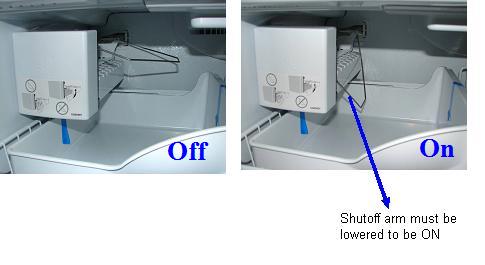Ice makers built into your refrigerator are super handy, but if something on a fridge requires troubleshooting, it’s usually our frosty freezer friend. The good news is you can probably diagnose and treat the most common problems without a service tech.
We’ve compiled some of our most frequently asked questions from about ice makers for you to print, save or bookmark (or frame).
Click on links below to jump to a section or scroll down and read the post in its entirety
How do ice makers work?
Troubleshooting
Still having problems?
Water constantly runs over a freezing plate in your ice maker. Meanwhile, minerals from your water are rejected; this mineral water, if you will, is drained with each ice-making cycle.
When the ice is thick enough, it slides down into a cutter grid that separates the sheet into cubes, which fall into the storage bin. A sensor determines when the bin is full and the ice maker shuts off until more ice is needed.
Key takeaways: The bin isn’t refrigerated so some melting will occur, especially if you take your good, sweet time loading the freezer after a trip to the grocery store. Also, higher temperatures in the freezer mean fewer cubes. So shut that door! Likewise, if you want more ice, dial your freezer to a colder setting, wait for 24 hours and see what happens. Wash, rinse, repeat — ice cubes!
If your freezer is completely cooled, you should get a batch of cubes every three hours. Note: It takes 24 hours for a newly installed ice maker to start making ice and 72 hours for it to swing into full operation. So be patient and remember to be supportive of your new fridge as it reaches its full ice-making potential.
Ice makers vary from model to model, but here are the most common issues and how to make them go away.
Is the control set to “ON”? It should be.
Is the water supply properly connected and turned on? It should be, also.
A loose drain cap can leave you with thin ice because water will empty from the water pan, so tighten that drain cap!
The drain tube could be clogged from sediment. Shut off the water line, wait, and turn it back on. This should help flush the sediment out. And speaking of the drain tube, make sure there are no kinks in it as they could prevent the flow of that rejected water out.
Make sure the metal arm on your ice maker is DOWN. (Remember: There’s no “on” in UP, but there’s “on” in dOwN.)
You probably have low water pressure. You need a cold water supply with pressure between 35 and 120 psi to properly operate the ice maker. If you have a water dispenser, you can test the pressure by filling a measuring cup for 5 seconds. If you end up with fewer than 3 ounces (a little more than 1/4 cup), your pressure is likely low.
Do you have a water filter in your fridge? It could be clogged or installed improperly. Remove the filter and see if your water flow improves. If it does, try reinstalling the filter. If that doesn’t work, buy a new filter.
Is your dispenser locked? It might sound stupid, but that’s probably why you didn’t check it before you checked this. Press and hold the lock button for several seconds to unlock.
Has there been a recent power outage? If power goes out for more than one hour, some models disable the dispenser. Press and hold the reset button to fix this. (Some models beep when they’re finished resetting.)
Check the ice chute for large clumps or cubes that are blocking it (continue below)
Pull any clumps out out of the dispenser and wipe the area out with a warm, wet cloth and then make sure to give it another once-over with a dry cloth. Ice clumps in the bin could also be your problem, so give the bin a good shake. If the clumps don’t separate, empty it and clean it out. This is also the solution is ice has formed around the auger (that usually-metal spiral thingy in the middle of the bin). Remember: It’ll take 24 hours to the bin to refill.
Ice clumps aren’t always because of melting. Even if freezer temperatures stay well below freezing, water molecules can condense and refreeze back together where the cubes are touching each other. So naturally, clumps can be lessened with more frequent use of the ice dispenser (i.e. don’t ignore it for a week).
Ice cubes can clump because of increased moisture due to a bad dispenser seal or gaps on in the freezer-door gasket (the rubber that seals to the freezer cabinet — try rubbing Vaseline on its face if it’s not sealing.) You’ll know bad seals are the culprit if there’s frost on the cubes. Unwrapped fresh food in the freezer can also be releasing the extra moisture.
Call us at (651)222-001, option 4. We have a group of real, customer service representatives who answer the phones right here in our St. Paul headquarters/warehouse from 8:30-5:30 Monday through Friday.
Or you can contact the manufacturer directly, if you prefer.
Take some time to leave your own maintenance tips in the comments. What’s gone wrong? What works to fix it and what doesn’t?







